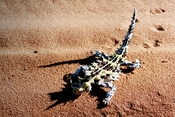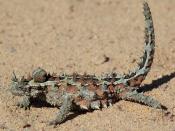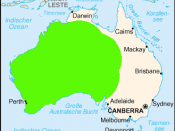Species and Habitat ResearchThorny DevilWhat is its common name and species nameThe Thorny Devil (Moloch horridus) is also known as the Thorny Dragon, Thorny Lizard, or the Moloch.
What are its characteristicsThe thorny devil has many quirky characteristics. It is an extremely fast eater and is capable of consuming as many ad 45 ants a minute. An adult Thorny Devil can eat up to 2500 ants in a single meal.
The Thorny Devil is covered in thorn-like spines. It has a knob-like spiny appendage located on the back of its neck, which acts as a false head when threatened. The Thorny Devil tucks its real head between its forelegs leaving its false head exposed. Thorny devils also inflate themselves with air as another defence mechanism, puffing up in the same manner as puffer fish to make themselves look larger and harder to swallow.
Levels of classificationKingdom: AnimaliaPhylum: ChordataClass: ReptiliaOrder: SquamataFamily: AgamidaeGenus: MolochSpecies: M.
horridusRequirementsThe food that the devil mainly eats is ants. Lives mainly in the desertRangeArid scrub and desert over most of central Australia. In particular, it inhabits sand plains and sand ridge desert within the interior and mallee belt.
HabitatThe Thorny Devil lives in the Western and central deserts. The climate in the desert is very dry.
Abiotic:Biotic:1. Sand2. Air3. Sometimes water4. RocksNicheThe niche of the thorny devil would be the hot and dry environment of the desert. All thorny devils are found in central Australia, because the majority of South Australia is covered in hot desert.
Tolerance LimitsThe thorny devil is used to very harsh temperature. The blazing hot sun of the desert in the afternoon and the blistering cold nights.
Population DistributionThorny devils are found throughout out Australia's interior desertCommunityThe thorny devil comes under the lizard/ reptilian communityInteractionThe thorny devil lives in the desert and there aren't many animals that choose to live in the same location as them. Obviously they have predators which could be birds or creatures that are bigger than them. However I cannot find any interactions present with another animal.
ConservationThe status of the thorny devil is secure. They are not in any real threat. However there have been numerous reports of thorny devils being run over by cars.
Migratory speciesMany animals migrate to Australia and its territories annual migrations. A migratory species that spends its time in Australia is a group of animals that temporarily move to Australia because the conditions in their native environment are not suitable for them to survive.
Birds are one of the major species that migrate. Migration is necessary for birds because Food, water, protective cover, and a sheltered place to nest and breed are basic to a bird's survival. But the changing seasons can transform a comfortable environment into an unliveable. Food and water supply can disappear, plant cover can vanish, and competition with other animals can increase.
Bibliographyhttp://www.sydneywildlifeworld.com.au/downloads/images/SWW_Thorny_Devil.jpghttp://en.wikipedia.org/wiki/Thorny_devil#Appearancehttp://en.wikipedia.org/wiki/Thorny_devil#Appearancehttp://australian-animals.net/http://www.paulnoll.com/Oregon/Birds/migrate-why.htmlhttp://www.environment.gov.au/biodiversity/migratory/waterbirds/index.html


